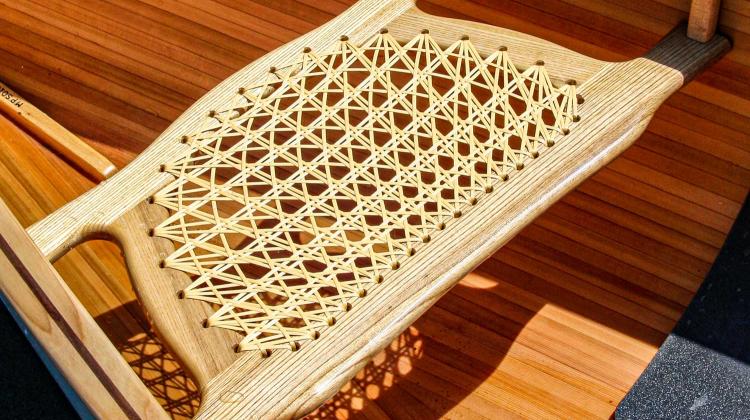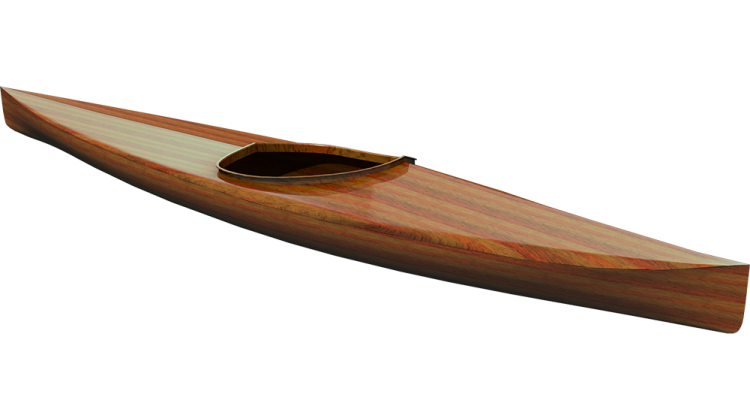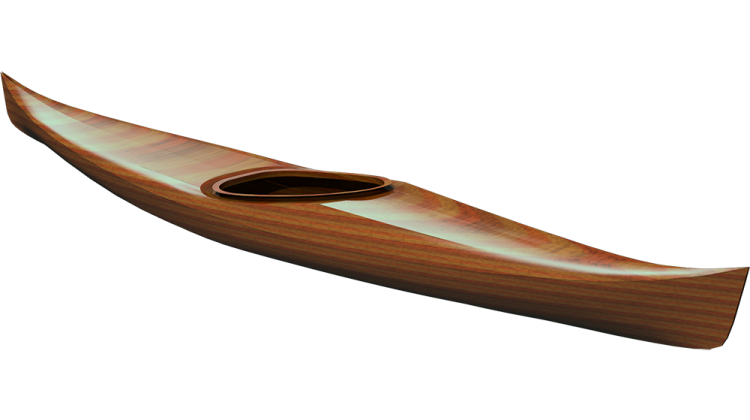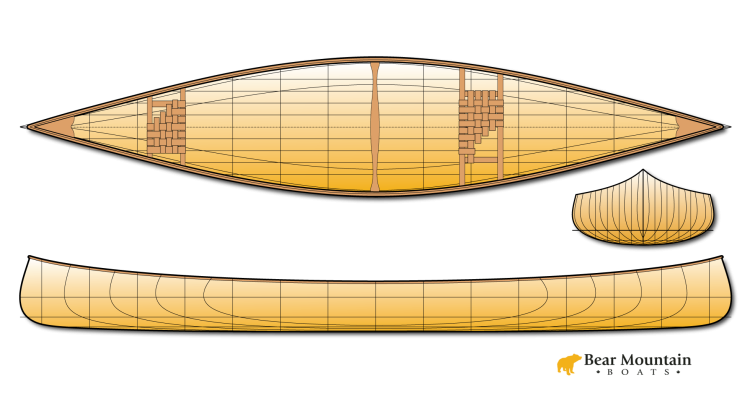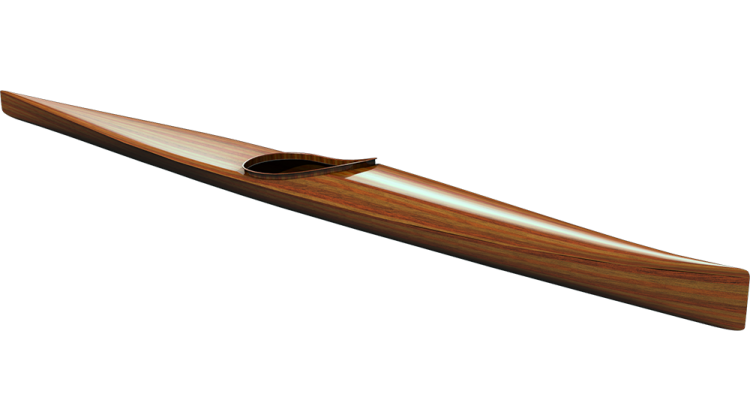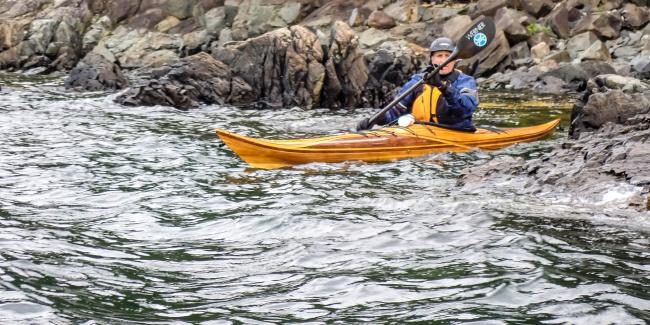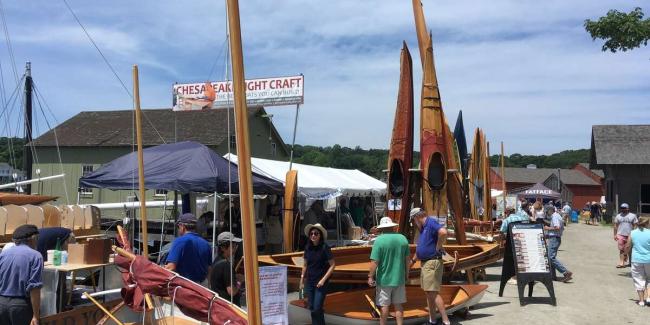Transcript
Hi I'm Nick Schade at Guillemot Kayaks, welcome episode number 15 of my series on make the strip planked Petrel Play kayak.
In the last episode I installed a hatch, deck line fittings and did end pours, in this episode I'll finish up the hatch and varnish the interior of both the deck and hull before joining them together.
The hatch will have a gasket to provide a seal. That gasket needs a smooth surface to seal against. Since the thin interior fill coats leaves the texture of the fabric showing, I need to apply another fill coat around the perimeter of the hatch.
I mask of the middle of the hatch and then paint on epoxy with a little colloidal silica added to thicken it slightly. While I'm at it I'm sealing the end grain around the hatch edge.
A little blast from a heat gun pops bubbles and levels out the surface.
When the epoxy has tacked up a bit, I peel off the masking tape.
I need to scuff up the interior to help the varnish stick. Since I want to keep the weave texture of the glass fabric, I can't just sand everything flat. I cut a circle of synthetic steel wool and use that on my small random orbital sander. The wooliness of the material does a good job of de-glossing the epoxy surface without sanding out the texture.
Both the deck and hull get the same treatment.
I don't want to get varnish along the sheer line because I'm going to have to epoxy in fiberglass tape along the deck-hull seam, so I mask off the top edge.
The whole inner surface below the tape will be coated in varnish. While the interior will not see much Ultra-violet light, the varnish is still good protection for the epoxy. Since the ends of the kayak will be almost completely inaccessible when completed, now is the time to prevent problems later.
I use the same brushing pattern for varnish as I did for the heavy epoxy fill coat discussed in episode 10. First I apply the varnish with heavy horizontal strokes, then level it out with lighter vertical strokes, followed by very light horizontal strokes to tip off the bubbles.
At the chine, it can be helpful to break up the vertical strokes into two sections for above and below the chine.
Irregular shapes such as the deck fittings are drip producers. I carefully work my way around the bump using my brush to sponge up excess varnish at the end.
When the first coat has dried for about 10 hours, I apply another coat right over the top.
After those two coats have dried overnight, I de-gloss again.
A tack cloth cleans out any accumulated dust.
A third coat of satin varnish provides the final finish for the interior of the kayak.
I left the same tape on for all three coats.
The top edge of the sheer still has a bit of a rough edge left over from the interior glass, plus there are some puddles of epoxy here and there. I need to make the sheer fair and smooth to ensure a tight fit between the deck and hull.
I use a block plane, rasp and or a sanding block to clean up the edge. I don't want to round it over, but instead make a pair of nearly matching bevels on the hull and deck.
This will require some test fits. Here I see the end pour needs to shaved down a little.
With the ends fitted well, I want to check the fit along the length. I temporarily tape the seam together looking for tight spots. I mark these with some blue masking tape so I can find them when I take the deck off again.
Satisfied with the fit, I clean out the interior then lay in some painter's masking film. This has tape along one edge and a lot of static cling to hold it in place. This will keep me from getting much epoxy on my fresh varnish.
A strip of green tape above the masking film defines the edge of the fiberglass seam tape. I'll be able to peel this up after laying in the seam tape on one side, without peeling off the masking film before seaming the other side.
Denatured alcohol cleans off any dust or contaminants where I'll be epoxying down the interior seam tape.
I mix up some epoxy thickened with wood flour to apply to the tops of the endpours. This will secure the deck down at the ends.
Now I start clamping the deck to the hull with glass-reinforced packing tape.
The thing that is going to hold the sheer line seam in alignment is friction. This is created by forcing the deck down on to the hull with the tension of the packing tape. What I'm saying is: inorder for this to work, the tape must be very tight.
I use a tape dispenser that lets me really pull hard on the tape, stick it down to the hull while I'm pulling on it and then easily cut the packing tape after it is in place.
If I cannot reach inside the boat to push the seam into alignment, I can use a thin putty knife to lever the seam into position while I tape it tightly together.
The hull and deck are really quite flexible, so even if they don't align perfectly initially, you can usually bend them to line up. While the tape might have trouble holding initially, with enough tension and friction between the sheers, I've successfully joined together badly mismatched pieces.
Depending on how easily the seam comes together, I usually end up with tape every 4 to 6 inches or 10 to 15 cm.
While applying epoxy to the inside seam, there is bound to be some that leaks out. A strip of masking tape along the seam will contain it, but to avoid large bumps I want to apply the tape wrinkle free and smooth.
I find it helps to apply it to the hull and then fold it up on to deck after.
We want gravity helping the task of taping the inside seam, so I secure the kayak up on edge.
A little tape assures it doesn't do something unexpected.
The inside seam will be reinforced with 3-inch-wide pre-woven fiberglass tape. I measure a length from about 6" shy of the stern to 6" short of the bow.
A piece of masking tape placed to align with the center of the cheek plate in the cockpit gets marked with an arrow point to the bow to help get the glass back in the correct spot.
I roll or fold up the strip of tape to transfer it from the boat to a table covered with a piece of waxed paper.
The strip of cloth now gets completely saturated with epoxy. The cloth is actually a 9 ounce fabric that takes a while to soak up the resin, so I brush it on heavy and give it time to soak in.
While the cloth is absorbing the epoxy, I brush more resin on the seam. I reach as far up as I can with my arms and then use a brush screwed to the end of a stick to spread the resin up into the end.
I roll up the saturated tape to transfer it back to the kayak. I roll from each end towards the middle where I marked the masking tape with the cheek plate locations.
Bringing the roll over to the boat, I align the tape behind the center of the cheek plate, making sure my arrow is pointed towards the bow. I can now roll out the tape along the seam as far as my arms will reach in each direction.
When I get beyond my arms reach, I again switch over to the brush on a stick. I just want to unroll the tape down the seam between the green masking tape. This takes some patience. You can steer the roll one direction or the other by pushing it with the brush.
Mistakes happen. Depending on your personality you may find that cussing helps. Others may try to manipulate the tape with the brush in a fruitless effort to make the situation right.
The solution that works is to just pull the cloth back, re-roll it and install it again. The epoxy is setting up while you fuss around, the quicker you get on with the show, the better off you will be.
This time I checked there were no snags before pulling back the stick.
With the tape properly in the bow I now want to smooth it out and make sure its well stuck down by brushing on a bit more epoxy resin.
Now to do the other end. Hopefully, it will go more smoothly this time.
I let the first side set up sufficiently that it won't fall off when I flip the kayak over to do the other side.
Here, I'm marking the center of the cheek plate and reference arrows to guide the strip of tape back to the right spot after it has been wet out.
The marks on the tape will be hidden behind the cheek plate and won't be visible in the finished kayak
I had a few issues again in the bow, but with patience and persistence it worked out fine.
We just about have something that looks like a kayak. In the next episode I'll make the outer stems, and apply another layer of fiberglass over the hull and reinforce the outside seam.
Be sure to post any questions you may have to the comments area.
Until the next episode, happy paddling and thanks for watching.

